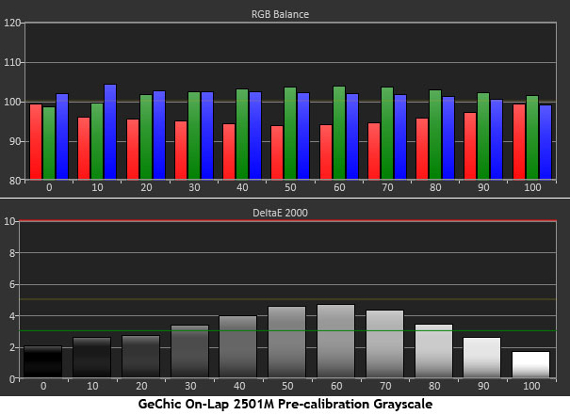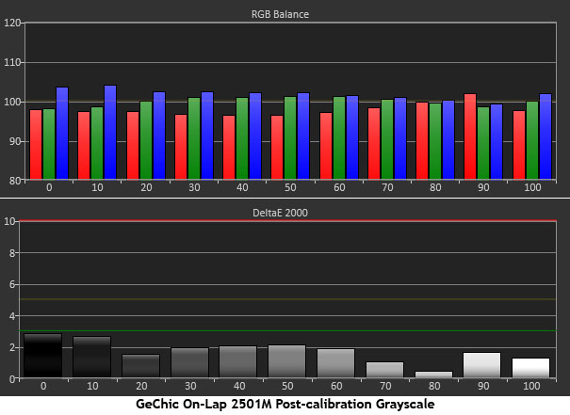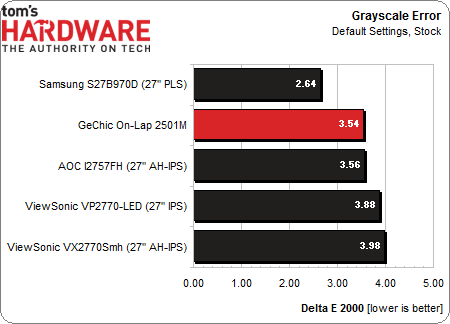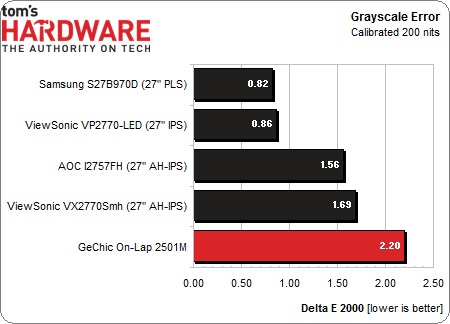GeChic On-Lap 2501M 15.6" Battery-Powered Monitor, Tested
Do you ever wish you could watch video on something larger than a smartphone when you're on the road? GeChic thinks it has an answer with the On-Lap 2501M portable monitor. We benchmark the display to see if its performance matches its convenience.
Results: Grayscale Tracking
For a product like the On-Lap 2501M, stock grayscale performance is very important since it’s unlikely that a user would calibrate this display. It is important that the color of white be consistently neutral at all light levels from darkest to brightest. Grayscale performance impacts color accuracy with regard to the secondary colors; cyan, magenta, and yellow. Since computer monitors typically have no color or tint adjustment, accurate grayscale is key.
The stock measurement shows a slightly cool result. Fortunately, green and blue track together, so the overall tint to white is barely noticeable. This is affirmed by the Delta-E numbers, which just barely exceed the visible level from 30 to 80 percent. The best stock setting for color temp is the 6500 K preset.
Adjusting the RGB sliders and increasing the brightness to maximum produces the following result. You can see Delta-E values are now all below three.
Green and blue track fairly well, but red starts to rise as the signal level increases. Turning up the red slider any higher produces a visible tint to the brightest whites, which is simply unacceptable for a computer monitor.
Compared to more expensive IPS monitors, the On-Lap does pretty well.
With an average stock Delta-E error of only 3.54, you are unlikely to notice any tint to the white balance. This is very good performance.
Calibrating the On-Lap only reduces the error by 1.34 Delta-E. You're going to notice the difference in lost contrast much more than the difference in white balance.
Get Tom's Hardware's best news and in-depth reviews, straight to your inbox.
As mentioned, calibrating the On-Lap reduces its contrast performance by around 19 percent, which is enough to be visible to the naked eye. Since dynamic range is still the ultimate metric for image quality, we recommend leaving the panel in its stock configuration and adjusting the brightness to taste. Dialing in the white balance won’t make an appreciable difference, and the reduction in contrast just isn’t worth it.
Current page: Results: Grayscale Tracking
Prev Page Results: Gamma And ANSI Contrast Ratio Next Page Results: Color Gamut And Performance
Christian Eberle is a Contributing Editor for Tom's Hardware US. He's a veteran reviewer of A/V equipment, specializing in monitors. Christian began his obsession with tech when he built his first PC in 1991, a 286 running DOS 3.0 at a blazing 12MHz. In 2006, he undertook training from the Imaging Science Foundation in video calibration and testing and thus started a passion for precise imaging that persists to this day. He is also a professional musician with a degree from the New England Conservatory as a classical bassoonist which he used to good effect as a performer with the West Point Army Band from 1987 to 2013. He enjoys watching movies and listening to high-end audio in his custom-built home theater and can be seen riding trails near his home on a race-ready ICE VTX recumbent trike. Christian enjoys the endless summer in Florida where he lives with his wife and Chihuahua and plays with orchestras around the state.
-
mayankleoboy1 So even though the hardware itself is excellent, the final product is too niche-y to sell ?Reply -
slomo4sho A portable monitor at the conveniently low price of an entry level tablet or chromebook... I see real utility here.Reply -
warezme It is an industry artificial block in my opinion. All they would have to do is include a little extra circuitry to the existing pads for an HDMI input and viola, you could use your pad as a monitor to another device. Most pads have at least that resolution on some even better. I would never buy this item unless it was under $150 or less. It is a one trick pony with a low resolution screen.Reply -
groundhogdaze I'd love to have one of these portable monitors. I've go a bunch of headless PC's that I need to check every once in a while and don't want to lug a regular monitor around nor hunt for a power socket for the test monitor. If only the price were a little lower...Reply -
Fulgurant warezmeIt is an industry artificial block in my opinion. All they would have to do is include a little extra circuitry to the existing pads for an HDMI input and viola, you could use your pad as a monitor to another device. Most pads have at least that resolution on some even better. I would never buy this item unless it was under $150 or less. It is a one trick pony with a low resolution screen.I don't disagree that tablets could easily include an input, but to be fair, this product is far bigger than a tablet. It may only have a niche use, but it is clearly better suited for that niche use than a tablet screen would be.Reply -
Fulgurant FulgurantI don't disagree that tablets could easily include an input, but to be fair, this product is far bigger than a tablet. It may only have a niche use, but it is clearly better suited for that niche use than a tablet screen would be.Come to think of it, laptops should include inputs too -- but to my knowledge, they never have.Reply -
g00fysmiley interesting concept but would be nice if bluetooth connectivity wee there unless i am missing somethign it s hdmi only. touchscereen i know is pricier but again would add to utility. interesting product just as it is looks very limitedReply -
RedJaron Senor Kalyanhttp://us.aoc.com/monitor_displays/e2251fwuNice product, except it doesn't have its own power supply and can only take a USB signal over a DisplayLink driver. Makes for a nice quasi-mobile secondary monitor for computers, but it won't connect to most types of mobile devices like the GeChic will.Reply



